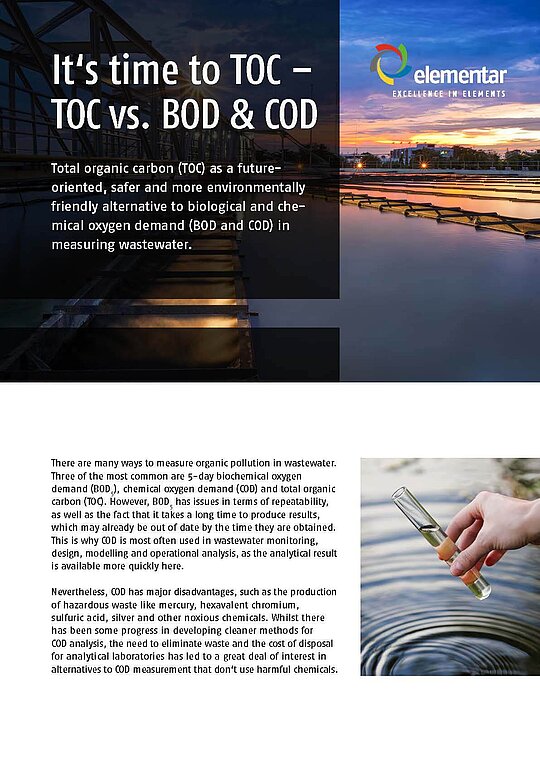It’s all in the mix – measuring organic content in wastewater
Measuring organic content in wastewater can be done in a variety of ways and depends on what you want to achieve with your analysis and how you want to proceed. The three main methods used are BOD, COD and TOC.
Biological Oxygen Demand (BOD) is the amount of oxygen consumed by microorganisms in 1 liter of water in five days (BOD5). This measurement is performed in a closed system to ensure no external influences affect oxygen concentrations. BOD analysis has very specific pH, nutrient, and chemical requirements and is unsuitable for process control. Results are based on the activity of microorganisms and can be biased if there are any toxic substances in the wastewater.
Chemical Oxygen Demand (COD) measures the oxygen needed to oxidize all the organic matter present in a sample. It differs from BOD by being much faster (between two and four hours per measurement) and uses a strong oxidizing agent rather than a microbial process. Potassium dichromate is used to fully oxidize all organic matter under extremely acidic conditions to create the final product: CO2. COD uses very toxic substances, and the handling and disposal of these reagents is highly regulated, as they are extremely poisonous.
Although some industries still use COD as a measure of the organic content of wastewater, many are shifting towards total organic carbon analysis (TOC).
Measuring total organic carbon (TOC) involves oxidizing the entire organic content of a sample, measured as a sum-parameter (as CO2). A liquid sample is taken, and the inorganic carbon is removed by acidification and purging. The organic carbon components are oxidized into CO2 which is then sent to a non-dispersive infrared detector (NDIR), where the CO2 is detected at a specific wavelength.
TOC can be used alongside COD and BOD5 and functions as an alternative in some cases, thanks to being faster and more precise, as well as cleaner and not dependent on hazardous chemicals. Furthermore, increasingly accurate detection methods have been developed, making TOC even more reliable and accurate, especially when it comes to the more complex materials found in industrial wastewater.
For BOD and COD analyses, the oxygen content needed to stabilize organic matter is the foundation of measurement. However, the values reported can differ based on the oxidation states of compounds within the sample, whereas carbon concentration (measured by TOC) remains constant. This makes an argument for TOC as a more suitable measurement method for the determination of organic content, since the result is independent of different oxidation states in the sample. The TOC value provides a quick, easy, and accurate way of assessing the organic content in a sample without the need for toxic chemicals.
To find out more about TOC and how it compares with BOD and COD, please download our whitepaper.
It's time to TOC - TOC vs. BOD & COD
Download

DOWNLOAD YOUR COPY
Fill in the form to receive your download link per e-mail.
Your contractual consideration for the free provision of the download is the subscription to our personalized newsletter. By clicking on the “download now” button, you therefore declare your acceptance of the receipt of personalized newsletters by e-mail by Elementar India Pvt Limited and its group companies as well as the evaluation of your user behavior in this regard and - if available - the merging of this data with your data in our customer database.
In order to receive newsletters from our group companies it is necessary to transfer your above-mentioned personal data to these companies. The data transfer is contractually required.
You are aware that the subscription to our personalized newsletter represents the contractual consideration that you provide for the free provision of the download. You can unsubscribe from the newsletter at any time with effect for the future. You can object to the future use of your data for advertising purposes at any time. For further information, please refer to our privacy policy.
